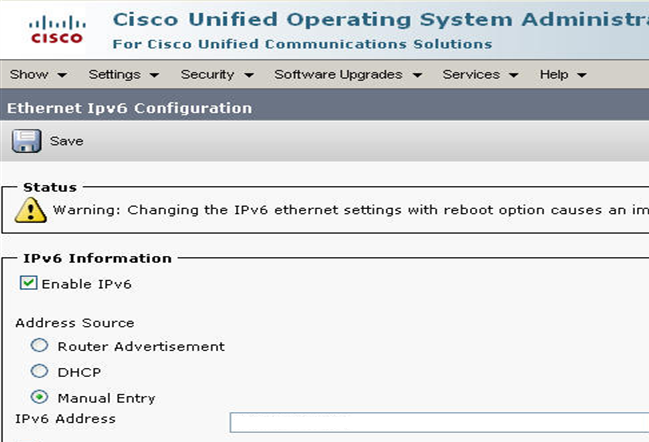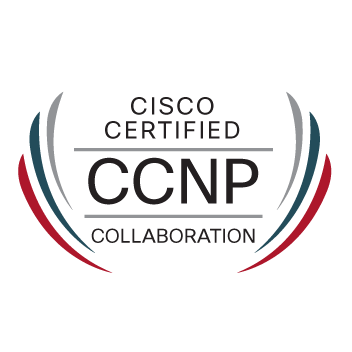- Cisco Community
- Technology and Support
- Collaboration
- Collaboration Knowledge Base
- Configuring IPv6 for CUCM
- Subscribe to RSS Feed
- Mark as New
- Mark as Read
- Bookmark
- Subscribe
- Printer Friendly Page
- Report Inappropriate Content
- Subscribe to RSS Feed
- Mark as New
- Mark as Read
- Bookmark
- Subscribe
- Printer Friendly Page
- Report Inappropriate Content
11-10-2011 11:48 PM - edited 03-12-2019 09:41 AM
Introduction
Internet Protocol version 6 (IPv6), which is the latest version of the Internet Protocol (IP) that uses packets to exchange data, voice, and video traffic over digital networks, increases the number of network address bits from 32 bits in IPv4 to 128 bits. IPv6 support in the Cisco Unified Communications Manager network allows the network to behave transparently in a dual-stack environment and provides additional IP address space and autoconfiguration capabilities to devices that are connected to the network.After you install Cisco Unified Communications Manager 7.1, your network can support IPv6 if you perform the necessary configuration tasks.
IPv6 impacts the Cisco CallManager, CTIManager, and Certificate Authority Proxy Function services in Cisco Unified Serviceability. Depending on the configuration tasks that you perform in Cisco Unified Communications Manager Administration, you may need to restart these services after you configure IPv6.
Requirements
Cisco Unified Communications Manager 7.1 on each server in the cluster.
The following Cisco Unified IP Phones that are running SCCP support IPv6-7906G, 7911G, 7931G, 7941G, 7942G, 7945G, 7961G, 7961GE, 7962G, 7962GE, 7965G, 7970G, 7971G-GE, and the 7975G.
DHCPv6 server that can issue IPv6 addresses and DNS server that can resolve host names to IPv6 addresses
If you want to do so, you can configure a Cisco IOS router or switch as a DHCPv6 server; for example, you can configure a Cisco Catalyst 3560 Series Switch or a Cisco Catalyst 3750 Series Switch that runs 12.2(46)SE (or later) as a DHCPv6 server. Before you configure this router/switch, verify that your router/switch supports the Cisco vendor-specific DHCPv6 information options that are required for IPv6 and DHCPv6 support.
- Cisco IOS release that is compatible with Cisco Unified Communications Manager 7.1(2), and that is installed and configured on the gateways and the Cisco IOS MTP
Configuration
Configuring IPv6 in GUI
To enable IPv6 in the Cisco Unified Communications Operating System and to ensure that the Cisco Unified Communications Manager server gets an IPv6 address, you must perform one of the following tasks:
- Run the IPv6 CLI commands in the command line interface.
- Enable IPv6 and configure the IPv6 address in the Ethernet IPv6 window in the Cisco Unified Communications Operating System.
Before configuring the cluster-wide parameters in CUCM, you must enable IPv6 on the cluster.
- In Cisco Unified Communications Operating System, choose Settings > IP > Ethernet IPv6.
- The Ethernet IPv6 Configuration window displays.
- To modify the Ethernet settings, enter the values in the appropriate fields. .
- Check the Update with Reboot check box. For the IPv6 settings in this window to take effect, you must reboot the server.
- Click Save. The server reboots immediately after you click Save.
Configuring the CUCM, at the application level for phone and intra-cluster communications
The IPv6 address can be used for both phone to UC server and between server communications This is required configuration for every server in the cluster where you wish to use IPv6.
Goto System > server
Enabling IPv6 for IP Phones to Server communications
You will first need to enable IPv6 cluster-wide, and then have the option of setting your signaling and media preference parameters either cluster-wide or per group of phone
Goto System > Enterprise Parameters
Goto Device > Device Settings > Common Device Profile
Note:- Before you set the Enable IPv6 enterprise parameter to True in Cisco Unified Communications Manager Administration, perform the following procedure. If you set the enterprise parameter to True before you enable IPv6 in the Cisco Unified Communications Operating System, the Cisco CallManager service runs in IPv4, and phones that have IP Addressing Mode of IPv6 Only cannot register with Cisco Unified Communications Manager.
Corresponding CLI commands:-
1. Enable IPv6 check box -->set network ipv6 service enable
These settings enable IPv6 in the Cisco Unified Communications Operating System.
Note:- For IPv6 to work, you must either check the Ethernet IPv6 check box or issue the equivalent CLI command.
You must perform this task before you set the Enable IPv6 enterprise parameter to True.
2. DHCP radio button -->set network ipv6 dhcp enable
If you want the DHCPv6 server to issue a non-link-local IPv6 address to the Cisco Unified Communications Manager server, click the DHCP radio button or issue the equivalent CLI command.
Note:- Ensure that the Cisco Unified Communications Manager server only obtains one non-link-local IPv6 address. If the server has more than one IPv6 address, Cisco Unified Communications Manager may not behave as expected.
3. Manual Entry radio button, IPv6 Address, Subnet Mask --> set network ipv6 static_address <addr> <mask>
Note:- These Ethernet IPv6 settings and equivalent CLI command allow you to configure a static IPv6 address for the Cisco Unified Communications Manager server. Configuring a static non-link-local IPv6 address assumes that you do not want the Cisco Unified Communications Manager server to get the IPv6 address from the DHCPv6 server or via stateless address autoconfiguration.
4. IPv6 Address -->show network ipv6 settings
These settings allow you to view the IPv6 address for the Cisco Unified Communications Manager server.
Tip :- If you decide to run the CLI commands instead of configure the Ethernet IPv6 settings in the Cisco Unified Communications Operating System, you must reboot the server for the changes to take effect.
Example output:-
IPv6 : enabled
DHCPv6 : disabledIPv6 addresses:- Address:2001:db8:c18:1:21c:c4ff:feef:ca0 Mask:64Scope:Global Duplicate:no
Address:fe80::21c:c4ff:feef:ca0 Mask:64
Scope:Link
Related Links
http://www.cisco.com/en/US/docs/ios/ipv6/configuration/guide/ip6-dhcp.html
- Mark as Read
- Mark as New
- Bookmark
- Permalink
- Report Inappropriate Content
Excelent guide!
- Mark as Read
- Mark as New
- Bookmark
- Permalink
- Report Inappropriate Content
Hi,
I would like to Know, if Cisco CP- 8900 Series phones support IPv6 protocol
Find answers to your questions by entering keywords or phrases in the Search bar above. New here? Use these resources to familiarize yourself with the community:


